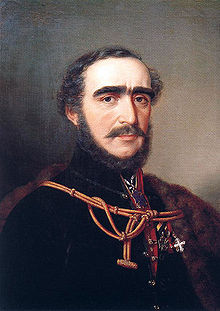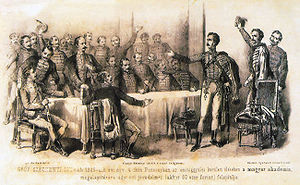- István Széchenyi
-
István Széchenyi 
Minister of Public Works and Transport of Hungary In office
23 March 1848 – 4 September 1848Preceded by office created Succeeded by László Csány Personal details Born 21 September 1791
Vienna, Archduchy of AustriaDied 8 April 1860 (aged 68)
Döbling, Austrian EmpireProfession politician The native form of this personal name is sárvár-felsővidéki gróf Széchenyi István. This article uses the Western name order.Count István Széchenyi de Sárvár-Felsővidék (pronounced [ˈiʃtvaːn ˈseːtʃeːɲi]; September 21, 1791 – April 8, 1860) was a Hungarian politician, theorist and writer, one of the greatest statesmen of Hungarian history. István is a Hungarian name equivalent of the name Stephen.
Contents
Family and early life
Széchenyi was born in Vienna. The Széchenyis were an old and influential noble family of Hungary. Traditionally loyal to the Habsburg dynasty, they were linked with noble families, such as the Liechtenstein, the Eszterhazy and the Lobkowitz. He himself spoke better German than Hungarian.[1]
István Széchenyi's father, Count Ferenc Széchényi, was an enlightened aristocrat. He founded the Hungarian National Museum. His mother was Countess Juliána Festetics. They had two daughters and three sons of which István was the youngest. He spent his childhood both in Vienna and on the family estate of Nagycenk, Hungary.
After his private education, the young Széchenyi joined the Austrian army and participated in the Napoleonic wars. He left the service as a first lieutenant in 1826 and turned his interest towards politics. Széchenyi travelled extensively in Europe and established important personal connections. The rapid modernisation of Britain fascinated him the most, and utterly influenced his thinking. The Count quickly became aware of the growing gap between modern world and his native Hungarian land. This recognition made him a determined reformer in the rest of his life. Széchenyi found early political support from his friend, the Transylvanian noble, Count Miklós Wesselényi, however their relation later weakened.
The great reformer
 Széchenyi offers one year's income of his estate for the establishment of the Hungarian Academy of Sciences.
Széchenyi offers one year's income of his estate for the establishment of the Hungarian Academy of Sciences.
Széchenyi gained wider reputation in 1825, by donating the full annual income of his estates for the establishment of the Hungarian Academy of Sciences. This was an important milestone in his life and for the reform movement.
Having gained recognition as a bold, reformer aristocrat, his devotion for progress became his obsession. In 1827 he organized the Nemzeti Kaszinó, a forum for the patriotic Hungarian nobility. The "Kaszinó" had an important role in the reform movement by providing an institute for political dialogues.
To reach a wider public, Széchenyi decided to publish his ideas. His series of political writings, the Hitel (Credit, 1830), the Világ, (World/Light, 1831), and the Stádium (1833), addressed the Hungarian nobility. He deeply condemned their conservatism and encouraged them to give up feudal privileges (e.g. free of taxation status), and act as the driving elite for modernization.
Széchenyi envisioned his program for Hungary within the framework of the Habsburg empire.[2] He was convinced that Hungary initially needed a gradual economical, social and cultural development and opposed both undue radicalism and nationalism. The latter he found particularly dangerous within the multi-ethnic Kingdom of Hungary.
Besides his comprehensive political ideas, his attention was vastly concentrated on the development of transportation, the vital factor behind economical growth.
Part of this program was the regulation of the lower Danube, from Pest to the Black sea. He became the leading figure of the project by the early 1830s. During that time, the river was dangerous for sailing, therefore it was not efficient as an international trading route. Széchenyi recognized its potential for both the region and Hungary, and was successfully lobbying in Vienna for financial and political support. He was appointed as high commissioner and supervised the works for years. During this period, he travelled to Constantinople and built up relations on the Balkan.
Another important Széchenyi initiative was the development of Buda and Pest as a major political, economical and cultural center of Hungary. He supported the construction of the first permanent bridge between the two cities, which nowadays bears his name as "Széchenyi Lánchíd". Besides its advantage in transportation , the "Lánchíd" became a highly symbolic construction, that forecast the later unification of the two cities as Budapest.
Széchenyi married Countess Crescence Seilern in 1836 in Buda.
Political rivalry with Kossuth
His relations with Lajos Kossuth were not good: he always thought Kossuth was a political agitator. Half of the country sympathised with him, and the other half with Kossuth. After the Hungarian revolution of 1848 he was convinced of the opportunity of achieving greater development of Hungary so he agreed to be the head of the Ministry of Transport and Social Affairs.
Retreat from politics
The failure of the revolution caused a mental breakdown, and his doctor ordered him to the Goergen Asylum of Döbling. Due to the loving care of his wife he regained his mental power, and wrote Önismeret (Self awareness) about children, education and pedagogy. Even more important was his work, Ein Blick (One Look) about the deep political problems of Hungary in the beginning of the 1850s.
Death and aftermath
Széchenyi committed suicide by a shot to his head on April 8, 1860.[3] All Hungary mourned his death. The Academy was in official mourning, along with the most prominent persons of the leading political and cultural associations (count József Eötvös, János Arany, Károly Szász). His statue in Budapest was unveiled on May 23, 1880, and in Sopron in the same year.
His son Béla became known for wide travels and explorations in the East Indies, Japan, China, Java, Borneo, western Mongolia, and the frontiers of Tibet. In 1893 he published in German an account of his experiences.[4]
Széchenyi's legacy is further carried along with the István Széchenyi Chair in International Economics, a privately endowed position at Quinnipiac University in Hamden, CT. The István Széchenyi Chair currently oversees, manages and develops three major academic programs aimed at strengthening relations with Central Eastern Europe, especially Hungary. These programs are the Hungarian American Business Leaders Program (HABL), the QU executive MBA Trip in Hungary, and the Foreign Lecture Series.
A film was made on his life in 2002, titled A Hídember ("The Bridgeman"). See its IMDb entry here.
His portrait is printed on the 5000 Hungarian forint banknote since 1990.
References
- ^ Kamusella, Tomasz (2008). The Politics of Language and Nationalism in Modern Central Europe. Palgrave Macmillan. http://books.google.com/books?q=Count+Istvan+(Stefan)+Szechenyi+(1791-1860),+spoke+better+German+than+Magyar&btnG=Search+Books.
- ^ http://www.gr-szechenyi.hu/iskolankrol/nevadonk.html
- ^ "Szechenyi, Istvan, Count". Encyclopedia Britannica, 11th Edition. http://www.1911encyclopedia.org/Ladislas_Szalay. Retrieved 2 May 2009.
- ^ New International Encyclopedia
External links
Hungarian Revolution of 1848 Belligerents Pretext Major battles Other battles Buda · Isaszeg · Vienna UprisingInfluence  Leaders for AustriaFerdinand I of Austria · Franz Joseph I of Austria · Eduard Clam-Gallas · Julius Jacob von Haynau · Josip Jelačić · Prince Franz de Paula of Liechtenstein · Alexander von Lüders · Fjodor Szergejevics Panutyin · Franz Schlik · Alfred I, Prince of Windisch-Grätz
Leaders for AustriaFerdinand I of Austria · Franz Joseph I of Austria · Eduard Clam-Gallas · Julius Jacob von Haynau · Josip Jelačić · Prince Franz de Paula of Liechtenstein · Alexander von Lüders · Fjodor Szergejevics Panutyin · Franz Schlik · Alfred I, Prince of Windisch-Grätz Leaders for HungaryLajos Batthyány · Józef Bem · János Damjanich · Henryk Dembiński · Arisztid Dessewffy · Artúr Görgey · Richard Guyon · György Klapka · György Kmety · Lajos Kossuth · Vilmos Lázár · János Móga · Alessandro Monti · Ferenc Ottinger · Mór Perczel · István Széchenyi · Bertalan SzemereCategories:
Leaders for HungaryLajos Batthyány · Józef Bem · János Damjanich · Henryk Dembiński · Arisztid Dessewffy · Artúr Görgey · Richard Guyon · György Klapka · György Kmety · Lajos Kossuth · Vilmos Lázár · János Móga · Alessandro Monti · Ferenc Ottinger · Mór Perczel · István Széchenyi · Bertalan SzemereCategories:- History articles needing translation from Hungarian Wikipedia
- Széchenyi family
- Hungarian nobility
- Hungarian politicians
- Hungarian writers
- History of Hungary
- 1791 births
- 1860 deaths
- 19th-century Hungarian people
- Hungarian politicians who committed suicide
Wikimedia Foundation. 2010.


